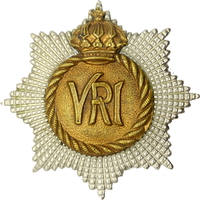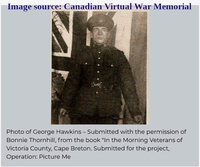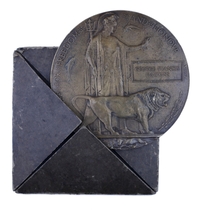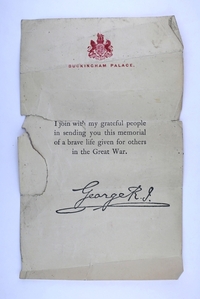
488223 Pte George Francis Hawkins
The Royal Canadian Regiment
By: Capt (ret'd) Michael M. O'Leary, CD, The RCR
George Francis Hawkins was born on 29 Oct 1897 on Jersey, one of the Channel Islands. His parents were English-born Phillip Hawkins and Newfoundland-born Susannah Budge. George was the fourth of five children born to his parents. George's father died in Newfoundland in 1899 and Susannah remarried on 1 Jun 1899 at Neil's Harbour, Cape Breton. The 1901 Canadian Census shows the combined family with nine children, five boys and four girls, ranging in age from 17 to 1.
The family also appears in the 1911 Census In these records, George's mother and step-father have only three young daughters still living at home. George does not appear in searches of the census and it may be that by age 13 he was already out of the home and working, and was missed in the census taking.
Hawkins' first introduction to military service came on 1 Nov 1915 when he was taken on the strength of the Composite Battalion at Halifax, N.S. This battalion, initially formed of companies stood up by maritime infantry units of the Canadian Militia, had been created as a garrison unit to replace The Royal Canadian Regiment in Halifax. On attesting with the Composite Battalion, Hawkins was given the regimental number 5073.
On 20 Nov 1915, Hawkins attested for service in the Canadian Expeditionary Force (C.E.F.) while serving with the Composite Battalion. An 18-year-old fisherman, Hawkins was described on his attestation paper as 5 feet 3 1/8-inches tall, weighing 109 pounds, with a 33-inch chest, a medium complexion, blue eyes, and dark brown hair. Watkins was noted as having a "large scar on abdomen, burn." His religious denomination was Episcopalian. Hawkins identified his step-father, William Warr, Neil's Harbour, Cape Breton, as his next of kin. On attesting for overseas service, Hawkins' regimental number was changed to the C.E.F. service number 488223 from a block of numbers assigned to the Composite Battalion.
Hawkins was medically examined for service in the C.E.F. on 28 Sep 1916. Changes from his earlier examination note his height at 5 feet 3 1/2 inches and his weight at 122 pounds. These perhaps indicate the regular rations of the army over the previous year were having a positive effect. The examination form also noted under distinctive marks that Hawkins had an abdominal scar that was "all over his abdomen (scald)." He also had scars on his right arm, right hip (scald), and inside of left shin.
On 30 Sep 1916, Hawkins was transferred from Composite Battalion to The Royal Canadian Regiment, joining the Regimental Depot at Halifax. Three days later, on 3 Oct 1916, he sailed from Halifax aboard the S.S. Californian as a member of an RCR Reinforcement Draft. Hawkins arrived in England on 13 Oct 1916 and was taken on the strength of the R.C.R. & P.P.C.L.I. Depot, Caesar's Camp, East Sandling.
The R.C.R. & P.P.C.L.I. Depot at was a short-lived depot unit that supported those two named regiments with drafts of reinforcements made up of soldiers returning to duty after wounds or sickness and new arrivals from Canada. The Depot was created on 13 Feb 1916 by separating it from the 11th Reserve Battalion, and it was disbanded on 20 Jan 1917 when it was absorbed into the 7th and 26th Reserve Battalions which took over its role.
After little more than two months at the Depot, Hawkins was struck off strength on 22 Dec 1916 in order to proceed overseas to France. He landed in France the following day, arriving at the Canadian Base Depot (C.B.D.), and was taken on the strength of The RCR.
Hawkins spent a month at the Base Depot before he was sent forward to join the Regiment. Leaving the Depot on 20 Jan 1917, it would be three days before he caught up with The RCR in the field as the unit rotated from the forward trenches to Divisional Reserve in the Mont-St-Eloy sector. The RCR would complete two more tours of the front line before moving into Corps Reserve at Bruay for the final months of preparation before Vimy Ridge.
The Regiment's "Battle Bar Document," which was prepared after the war by the Militia Department in anticipation of the possibility of clasps for the British War Medal, shows the activities of The RCR units under the heading "Battle of Vimy Ridge" with a return to the front line on 22 Mar 1917. While the common post-war view focuses that title on the two days of the assault on 9-10 April, for the troops in the field the operations around and on Vimy Ridge were much more expansive in time and space.
On the night of 7 Apr 1917, The RCR assembled in Grange Tunnel to await the start of the Vimy Ridge attack. The Battle Bar document succinctly summarizes the actions of the 9th of April:
9 Apr 1917
• 3.40 a.m. –Bn in assembly position.
• 5.30 a.m. –Bn advanced to the attack.
• 6.30 a.m. –Reported in FANNY & FEATHER trenches (very few casualties).
• 9.00 a.m. –Final objective taken and being consolidated. Large number of prisoners taken and connection established with both flanks. During the course of the day many enemy counterattacks were repulsed.
The Regiment's War Diary entry for 9 Apr 1917 lists the cost of the Regiment's success:
"Lieuts. Thompson, Blott, Churchill, Bole, Beck, and Rooks were Killed in Action. Lieuts. Barker, Davies, Captain Munn, Lieuts. Gray, Robinson and Lewis were Wounded in Action. The following numbers of Other Ranks were casualties. Killed in Action 50, Wounded in Action 159, Missing 65. It is presumed that the majority of missing will be found in Field Ambulance or will return from Other Units. Lieut. Foster wounded, at duty."
On that date, or possibly one of the following days before The RCR was relieved and moved to Villers-au-Bois late on 11 April, George Hawkins was numbered among the wounded. The numbers of casualties across the Canadian Corps and the challenges of the medical evacuation system to handle them has resulted in few details of his wounding and immediate care being recorded. What we do know is that on 14 Apr 1917, Hawkins was admitted to No. 2 Australian General Hospital, Boulogne. He was quickly evacuated to England and crossed the Channel on the hospital ship H.S. Jan Breydel. Concurrent with his evacuation from the theatre of war and admission to the Barnet War Hospital, Wellhouse Lane, Barnet, Hertsfordshire (about 20 Km north of central London), he was posted to the Nova Scotia Regimental Depot (N.S.R.D.) at Bramshott.
The Nova Scotia Regimental Depot was part of a new regionally based reinforcement system, with named Depots taking in troops from battalions raised in those areas in Canada and providing reinforcement drafts to similarly designated fighting units. The RCR, having been headquartered in Halifax in the decade before the War, was associated with the N.S.R.D. These Depots also became the parent unit for any soldiers returned to England from their affiliated battalions in France and Flanders.
Admitted to the Barnet War Hospital on 15 Apr 1917, Barnet would be treated for gun shot wounds (G.S.W.) of both legs. The term "G.S.W." could be used to refer to wounds caused by bullet, shrapnel balls, or shell splinters. His medical case notes, at the time of his transfer to the Military Convalescent Hospital, Woodcote Park, Epsom on 11 May 1917, noted "B.I.P., not healed."
"B.I.P.," or "B.I.P.P.," stood for bismuth-iodoform-paraffin paste. This was a new and effective antiseptic ointment invented in late 1915 by James Rutherford Morison at the Northumberland War Hospital. Effective in reducing infection in wounds, variations of the paste are still used by medical practitioners today.
Hawkins remained at M.C.H. Epsom until he was discharged on 18 Jun 1917. His case notes read: "superficial wound left thigh; penetrating wound right leg, has had massage and special exercise, fit Aiii." A medical category of Aiii classed him with "casualties fit as soon as they were hardened by exercise."
On discharge from hospital, Hawkins was taken on the strength of the 26th Reserve Battalion at Bramshott. On 11 Aug 1917, while with the 26th Res. Bn., Hawkins completed a military Form of Will. In this document, he declared that in the event of his death all his personal estate would be bequeathed to his step-sister, Miss Martha Warr, New Haven, Victoria Co., C.B., N.S.
Hawkins was posted from the 26th Res. Bn. to the 17th Res. Bn. on 15 Oct 1917. Less than two weeks later, on 26 Oct 1917, he was struck off strength and proceeded overseas again to rejoin The RCR in the field. He landed in France the following day and was taken back on the strength of the Regiment. After a short period spent at the 3rd Division Wing of the Canadian Corps Reinforcement Camp (C.C.R.C.), he joined the unit on 3 Nov 1917.
Relieved from a tour of the front lines on 4 Nov after suffering a total of 258 casualties (killed, wounded, gassed, etc.), The RCR spent a period of regrouping near Watou in the Ypres Sector between 5 and 12 Nov 1917. A continuing toll of killed and wounded for the Regiment in the first few days of this period suggest that the companies were returning to the front lines as working parties.
The RCR moved back into the forward area on 13 Nov 1917 and into the front lines the next day. The War Diary entry for 14 Nov 1917 reads as follows:
"The morning was spent in issuing Equipment, including Bombs, S.A.A. etc., etc. Cos. moved off in order "A" "B" "C" and "D" starting at 2.40 p.m. Platoons at 3 minutes interval. Relief of the 58th Cdn. Inf. Bn. reported complete at 8.30 p.m. The Battalion holds the line astride the PASSCHENDAELE –WESTROOSEBEKE road on the very top of the Ridge. "B" and "C" Cos. are in the Front Line. "A" and "D" Cos. are in Supports. 27th Cdn. Inf. Bn. on the Right and 42nd Cdn. Inf. Bn. on Left. P.P.C.L.I. in supports. Line runs W.25.c.00.20. to W.25.c.10.60. to V.30.b.70.00. to V.30.b.10.47. Trench strength of the Battalion 16 Officers and 465 O.R's. Battalion H.Q. at MEETCHEELE "Pill-Box". "B" Co. captured a German Light Machine Gun and four prisoners of the 54th Company 208th R.I.R's."
The next few days were costly for the Regiment adding nearly another hundred to the Regiment's casualties for the month. A narrative appendix with the month's War Diary noted that "The tour although lasting only three days was a very strenuous one. Enemy shelling of our lines especially the support areas was practically without cessation."
Among the wounded on 16 Nov 1917 was Private George Hawkins. While no specific details of his death are recorded, he was initially reported as "Killed in Action." This was later amended in Hawkins' records to read "Died of Wounds" which suggests he was evacuated to a battlefield medical facility before he died of his wounds.
For his service in the C.E.F., Hawkins was entitled to receive the British War Medal and the Victory Medal. These were sent to his step-sister, Miss Martha E. Warr at North Sydney, C.B., N.S. on 20 Jul 1922. George's brother, William Hawkins, Esq., Quarry Point, Glace Bay, C.B., N.S., received the Memorial Plaque and Scroll commemorating his sacrifice. Since George was unmarried and his mother had predeceased him in 1911, no silver Memorial Crosses would be issued in his name. The plaque and scroll would be despatched in 1921 and 1922.
George Hawkins has no known grave. He is commemorated on the Menin Gate Memorial at Ypres, Belgium. The Commonwealth War Graves Commission register for the Memorial has an entry for Hawkins which reads:
"HAWKINS, Pte. George Francis, 488223. Royal Canadian Regt. 16th Nov., 1917. Age 20. Son of Philip and Susan Hawkins."
Hawkins' name is also inscribed on the Cenotaph Memorial in Neil's Harbour, Victoria County, Nova Scotia.
Pro Patria
Visit a randomly selected page in The O'Leary Collection (or reload for another choice):
- The O'Leary Collection; Medals of The Royal Canadian Regiment.
- Researching Canadian Soldiers of the First World War
- Researching The Royal Canadian Regiment
- The RCR in the First World War
- Badges of The RCR
- The Senior Subaltern
- The Minute Book (blog)
- Rogue Papers
- Tactical Primers
- The Regimental Library
- Battle Honours
- Perpetuation of the CEF
- A Miscellany
- Quotes
- The Frontenac Times
- Site Map
QUICK LINKS
The O'Leary Collection—Medals of The Royal Canadian Regiment
Newest additions:
![]()
![]() SB-12725 Private Henry "Hank" Ard
SB-12725 Private Henry "Hank" Ard ![]()
WIA at Hill 187, Died of Wounds in Japan
![]()
![]() 2355331 Lance Corporal Albert Lorking
2355331 Lance Corporal Albert Lorking
Wounded in action, later a War Amps representative.
![]()
![]() 4334 / 477996 Pte Isaac Hamilton Wilcox
4334 / 477996 Pte Isaac Hamilton Wilcox
Permanent Force, South Africa, and C.E.F.
![]()
![]() 477019 Private Harold Ashcroft
477019 Private Harold Ashcroft
Transferred to the Tunnelers.
![]()
![]() 734231 Private Clark D. Thompson
734231 Private Clark D. Thompson ![]()
The older Thompson brother, killed in action.
![]()
![]() 733849 Private Norman Parker Thompson
733849 Private Norman Parker Thompson
The younger Thompson brother; post-war service in the Special Guard.
![]()
![]()
![]() A305 / 400305 Private Andrew Walker
A305 / 400305 Private Andrew Walker ![]()
"Previously reported Wounded, now Killed in Action."
![]()
![]() 823298 Pte Thomas Patrick Steele, M.M.
823298 Pte Thomas Patrick Steele, M.M. ![]()
… for gallant conduct in the field …
![]()
![]() P13066 Sergeant Harold Thompson
P13066 Sergeant Harold Thompson
Instrumental Soloist for over 20 years of Canadian Army service.
![]()
![]() 9609 / 477728 Private Albert Edward Piper
9609 / 477728 Private Albert Edward Piper
"Arrived from England as a STOWAWAY …"





